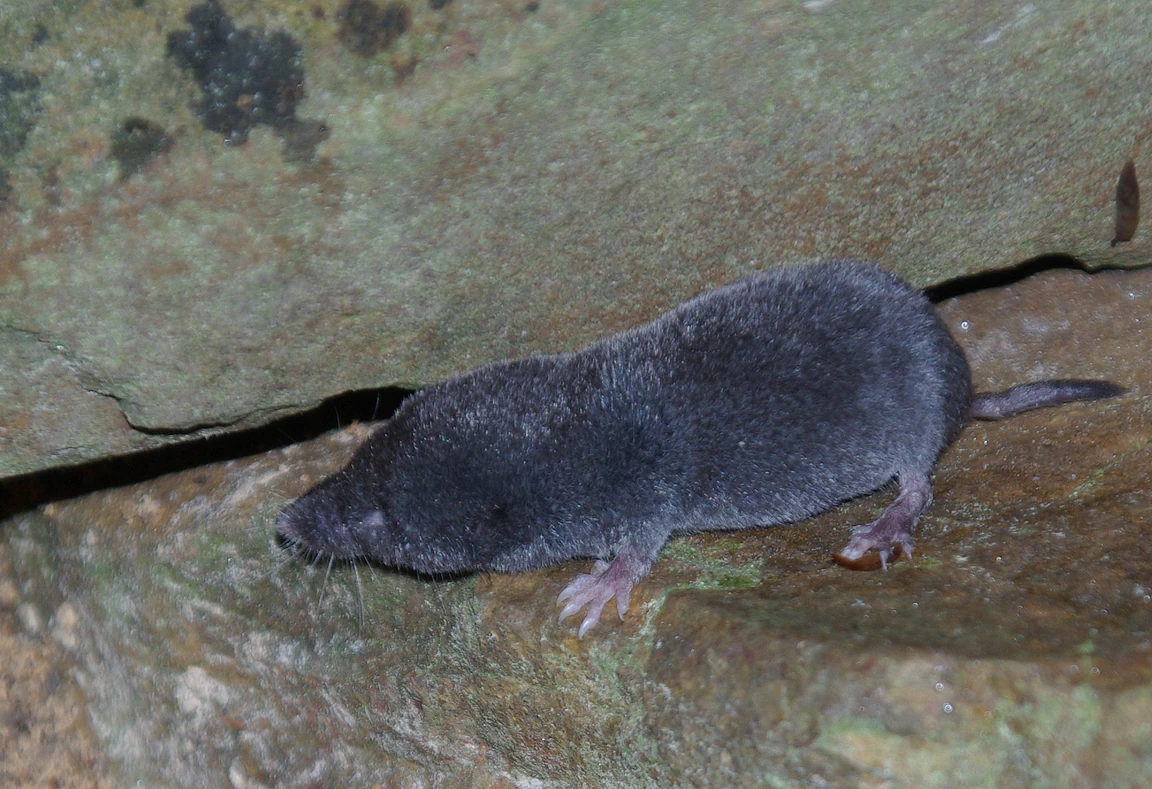

In a rural backyard, the carnivore hunts. Its bite is poisonous. Its blood-colored teeth are needle sharp. It never sleeps. Day and night, it kills and eats—one animal then another and another. Yet its hunger is never satisfied. As soon as one victim is devoured, another must be found.
It travels unseen through a subsurface labyrinth of tunnels and trails. Others of its kind live nearby in woods and grassy edges—a dozen, perhaps, on a single acre. Yet they seldom encounter one another, and the humans living 100 yards away are oblivious to their presence.
The carnivore’s fur is beautiful—slate gray with the sheen and texture of fine velvet. But nothing else about it is endearing. It has no visible ears. Its black eyes are hardly as big as pinheads. Its bewhiskered nose is long and rubbery, constantly sniffing and probing. Life for this insatiable animal is a steady quest for food and more food. The creatures it consumes each day would equal it in weight.
According to biologists, it is probably the most abundant mammal in the South, perhaps in the whole United States. Right now, several may be stalking unsuspecting animals in your backyard. Chances are good, however, that you have never seen the short-tailed shrew. Despite its tiger-like disposition, this extraordinary mammal is only four inches long and weighs less than an ounce.
The southern short-tailed shrew (Blarina carolinensis) is but one of 27 species of North American shrews. We seldom see it because of its small size and the fact that it spends most of its time under leaves on the forest floor or in brushy, grassy areas near water or woods. An Arkansas cousin, the least shrew, is one of the smallest mammals on earth, weighing only 1/7 to 1/4 ounce.
All shrews exhibit a nervous restlessness, and there is good reason for this. As the smallest living mammals, they have the highest rate of metabolism, for the “living” rate of animal tissue goes up as animal size goes down. To support their high rate of metabolism, shrews must eat huge quantities of food, usually insects, worms, snails and other invertebrates.
When the opportunity presents itself, larger animals are devoured as well. I once caught a short-tailed shrew and released it in a large terrarium that housed a small kingsnake, a large lizard and a very large tarantula. I assumed the kingsnake would eat the shrew. But 12 hours later, only the shrew, with slightly bulging stomach, remained. The tiny predator had transmuted the reptiles and spider into a small heap of droppings and a few calories of wasted heat.
Short-tailed shrews are the only mammals known to have a poisonous bite. Proof of this toxicity came decades ago when a Harvard anatomist discovered an unusual group of cells in the shrew’s salivary glands. Extracts from the glands were injected into mice. They proved highly lethal. A 3-pound rabbit succumbed in less than five minutes to an injection of extract from only 10 milligrams of salivary tissue. One shrew provides more than seven times this much venom.
No doubt, the shrew’s venom is powerful enough to kill a human if injected in the bloodstream, but the animal lacks an effective injection mechanism. Unlike poisonous snakes, it has no hollow fangs. The poison is mixed with the saliva, finding its way into a wound in very dilute amounts. Bites to humans cause pain and swelling but are extremely rare and have only been suffered by those attempting to handle a shrew.
Shrews are actually quite beneficial. They serve as an important check on insect crop pests. Ticks that drop to the ground when about to lay eggs also are greedily consumed. Meadow voles, which cause a great deal of damage to orchards, are an important fall and winter food. Shrews also serve as food for many raptors, reptiles and mammalian predators.
These tiny bundles of energy thrive in a world unsympathetic to the small in stature. In this case, however, it’s hard to dispute the fact that smaller is better. Thank goodness shrews don’t grow as big as tigers! None of us would be safe.
P.S. You can use this link to share this post: https://downhomearkansas.net/shrews-hidden-tigers-in-our-backyards/

Keith “Catfish” Sutton of Alexander, Arkansas, is one of the country’s best-known outdoor
journalists. His stories and photographs about fishing, hunting, wildlife and conservation have
been read by millions in hundreds of books, magazines, newspapers and websites. He and his
wife Theresa own C&C Outdoor Productions Inc., an Arkansas-based writing, photography,
lecturing and editorial service.




Get DownHome Arkansas blog posts, news, and more directly by email. Give us your name and email if you’d like to subscribe.